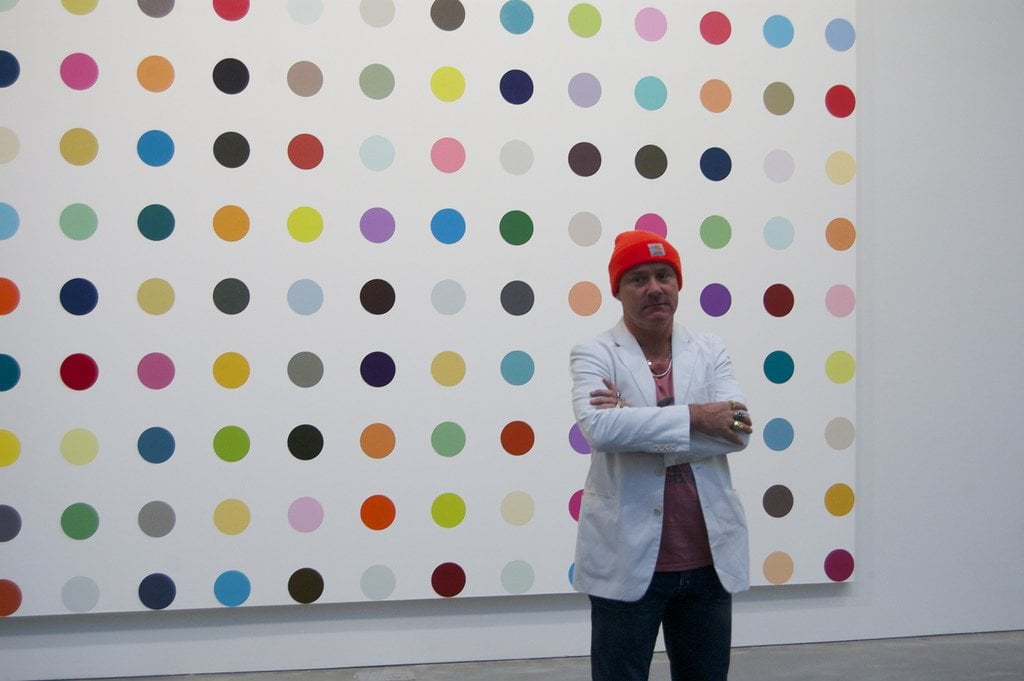The Western contemporary art world has become, at the highest level, a kind of celebrity entity – dominated by high price tags and fashionable, meaningless tat. Names like Jeff Koons, Damien Hirst, and Maurizio Cattelan echo around auction houses in London and New York. Hirst’s glitzy diamond-encrusted skull, ‘For the Love of God’ (2007) sold for £50 million, whilst oversized squeaky balloon animals and headless ostriches inhabit the hallways of the world’s wealthiest somewhere. All seek to wow with their wacky works, but most seem merely to evoke a bemused, ‘what?’ This doesn’t appear to matter to buyers though – because work is no longer valued by originality of concept, but simply by the number of zeroes it fetches at auction. Collectors have become the new critics in a consumerist society, and any concept of appreciation or comprehension has been eradicated.
When art is something tangible, it is easy for consumers to control creative practices. However, the increasing popularity in the past two decades of performative practices – seen in galleries like Perfoma and Tate Modern’s Tanks—have made this more challenging. Daniel Baumann (Director of Kunsthalle Zurich, Switzerland) postulated only last year, that this recent return of performance art was “a reaction against an increasingly object-obsessed art market”. This form can be neither bought nor sold easily by private individuals, hence is a rejection of the authority of wealthy consumers who lack apprehension and signifies a shift back towards artists’ power in contemporary art.
This idea is nothing innovative. When performance emerged in the later 1960s, it did so in retaliation to the materialism of 1950s kitsch pop culture. Having roots in Dada even before that, the medium has always placed emphasis on the conceptual, rebuffing capitalism’s influence.
Speaking on the practice, Marina Abramovic explained that it was fundamental to the reassertion of ideas, as “collectors have to re-educate themselves, so that the idea [behind a piece] becomes as sought after as the physical object” – and artists engaging in the practice have demonstrated this importance of meaning to the movement by addressing political and social circumstances in their actions.
Yayoi Kusama scrubbed down a Soviet flag before the UN buildings when the USSR invaded Slovakia in 1968—because ‘the Soviet Union is dirty’, and staged licentious ‘love-ins’ outside of the New York Stock Exchange in protest, during the height of the Vietnam War, as “the money made with this stock is enabling the war to continue”. Caroline Schneemann asked men and women to strip to their underwear and roll around in raw meat and paint in ‘Meat Joy’ (1964), as a gruesome and sensual rejection of traditional ideas about female sexuality.
Contemporary performance art continues to occupy the realm of the conceptual, addressing cultural circumstances. Nate Hill’s ‘Punch Me Panda’ (2010) for example, tackled stress in contemporary society, as the artist donned a fluffy panda suit then roamed the streets of New York inviting frustrated workers to take a punch. Whilst Abramovic’s ‘The Artist is Present’ (2010) forced viewers to confront where the value of art lies as they sat in front of the artist in an empty room and simply stared into her eyes for three months. But performance is about more than emphasizing the significance of ideas though, as it signals a realignment of authority in the contemporary art world.
Baumann assumes that this return of performance’s popularity indicates a shift away from consumers towards ‘audience-driven’ art. However with regards to the contemporary, this is not necessarily true. The practice does not remove itself entirely from the art market – proven in the surfacing of questions on copyrights and re-enactments over the past decade. Institutions such as the Tate have attempted to purchase rights to works, establishing the ‘Collecting the Performative’ project for this purpose, whilst MoMA launched a similar enterprise in 2008 focusing on the preservation and ownership of performance pieces. Artists are rapidly buying into this too.
Tino Sehgal has begun to sell his works in the form of verbal transactions, under the watchful eye of a lawyer. The Tate bought ‘This is Propaganda’ (2002) in this format, with the staff being briefed orally on exactly how to re-enact the piece. Selling for between $85,000 and $145,000, this is a realistic and legitimate investment for a gallery where there is space to exhibit the work. But the format does not present itself readily for a private collection – there is little point acquiring instructions if you can only perform the work to yourself.
The resurfacing of performance art in the contemporary field does not wholly reject institutions then, nor the consumer. But with an increasing number of performance galleries emerging – like New York’s Performa – and evermore existing galleries pushing for higher representation of the practice – such as the Lisson and the Serpentine – it is certainly a move directed against the commoditization of art. Founded in 2004 by art historian and curator RoseLee Goldberg, “Performa” embodies what this shift is really about, increasing diversity and pushing for new direction in art-forms, reasserting the power of art-historical establishments, and dissipating the control of the uninformed consumer in contemporary art.



